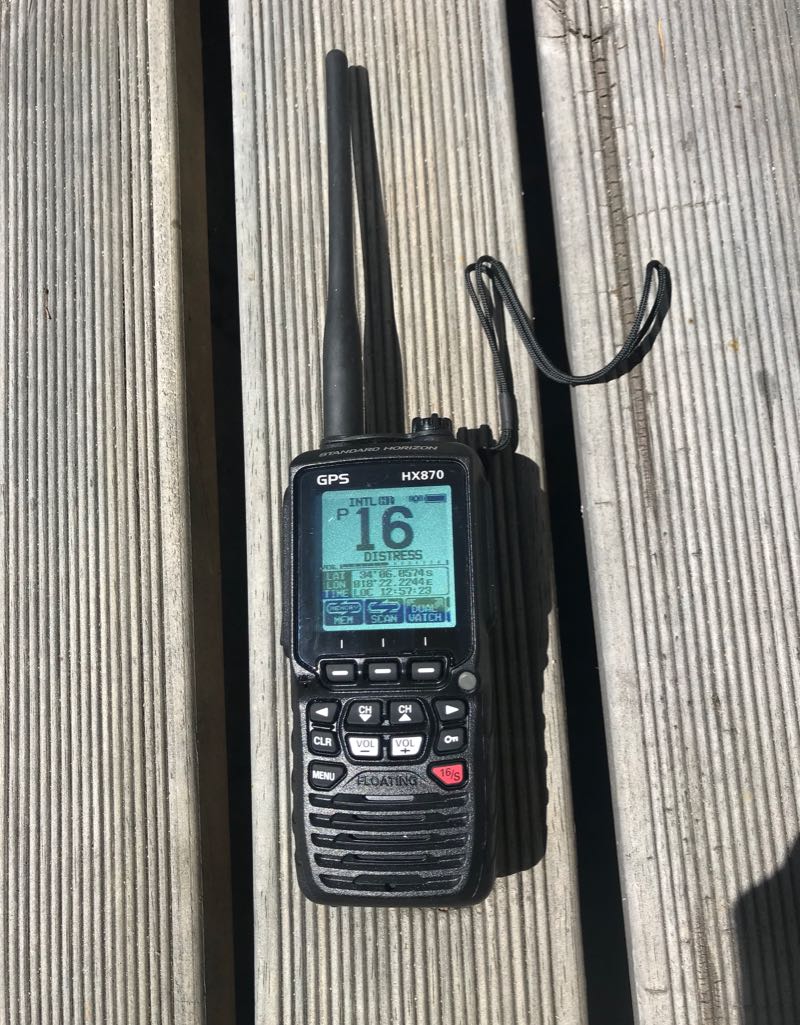
Many paddlers use Personal Locator Beacons, or tracker apps like SafeTrx on their mobile phones. But handheld VHF radios are also a great choice to consider – especially when they’re DSC-capable like the Standard Horizon HX870E.
Communication at Sea
These days we have choices if we need to call for help:
- A tracker app (like SafeTrx) on your mobile is a great choice. It’s free and all you need is a waterproof pouch for your phone.
- Personal Locator Beacons are popular in some parts of the world – and they work everywhere.
- Flares are a good option too. I summoned help for a fellow paddler using pencil flares in daylight. Worked like a charm.
But all of these things have drawbacks:
- Mobile phones can be tricky to operate through a pouch, and they need a reliable GSM signal, which isn’t always available.
- PLBs have to be operated properly (the unit must be held clear of the water) and the communication is one-way – you can’t tell if someone is coming to get you.
- Pencil flares don’t last long, and smoke flares are bulky and usually you’ll only have one with you.
VHF radios, while also not a silver bullet, have some unique advantages:
- They’re really, really easy to operate – push a button to talk.
- Modern DSC-capable radios incorporate a GPS and automatically broadcast your position to vessels equipped with DSC-receivers (like the NSRI rescue boats).
Repeater Stations
Here in South Africa, the maritime authorities maintain a chain of radio repeaters along the coast, which extends the range of VHF communications.
For example, False Bay, home of the (in)famous Miller’s Run, is surrounded by mountains – and VHF signals from handheld radios are picked up by Cape Town Radio over the entire length of the Miller’s Run.
But even in areas where there isn’t the same infrastructure and the signal is limited to line-of-sight, a radio can be invaluable when talking to a nearby rescue craft. When we did our Search and Rescue exercise some years ago with the NSRI, I was astonished at how limited the field of view was out of the rescue boat.
It’s vital to be able to talk to your rescuers because you’ll most likely see them long before they see you.
Standard Horizon HX870E Marine Handheld VHF Radio
Having used a basic ICOM VHF for many years, I recently switched to the DSC-capable HX870E and have found it to be a reassuringly robust and feature-rich radio.

The HX870E has a big, bright screen that is easy to read in direct sunlight
The major differences between the HX870E and conventional VHF radios like the ICOM M36 are that the HX870E:
- Has a built in GPS receiver.
- Is DSC-capable. This means that it can send a digital message to other DSC-capable receivers, including your GPS coordinates. If you send a distress message, it will automatically activate alarms on all DSC-capable receivers.
User Interface
The big screen is bright and easy to read, while the menus are straight forward and intuitive to use.
The DSC Distress button is located to one side, with a cover to prevent accidental activation. To call for help, you simply lift the flap and press the red button for three seconds. Thereafter the radio will broadcast your status and position until it receives an acknowledgement from another DSC-capable unit.
Another advantage of DSC is that you can communicate privately over the digital channel with another DSC-capable radio without broadcasting to the world.
Other Features
A number of other features are built into this radio:
- It floats.
- It has a high capacity 1,800mAh battery and comes with a rapid charger (3hr to from empty).
- On the front of the radio, there’s a programmable strobe light that switches on a automatically if the radio is submerged.
There’s never a silver bullet
There’s no question – if you go offshore in any kind of vessel, you should have some means of communication.
But whatever you choose, flares, PLB, radio or mobile phone, be aware that none of them is entirely fool-proof, and ideally you should have more than one of them AND you should have a plan B in mind should they not work.